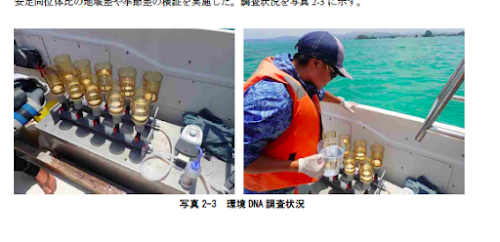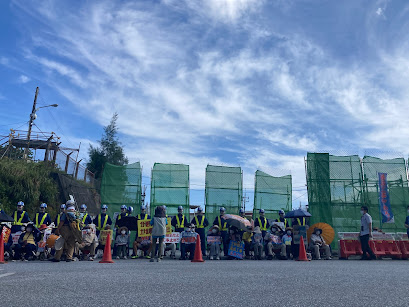Okinawa Prefectural Government Latest Report: Dugong Feeding Trails found off Northern Okinawa Island /沖縄県の最新ジュゴン報告書:沖縄本島北部でジュゴンの食み跡を確認
日本語バージョンは下にあります。
Okinawa Prefectural Government Latest Report: Dugong Feeding Trails found off Northern Okinawa Island /沖縄県の最新報告書:沖縄本島北部でジュゴンの食み跡確認
 |
| Red rectangles indicate that dugong feeding trails were found. Geen rectangles indicate no dugong feeding trails were found. Image Source: Okinawa Prefectural Government |
First, dugong feeding trails were found near Yagaji Island and Kouri Island in July 2020 and off Izena Island in July and October 2020. These results correspond to the findings presented in the Japanese Ministry of the Environment's latest dugong report (2021).
This is a much-awaited confirmation. Dugongs(we don't know how many) are surviving in the waters of northern Okinawa Island, and the shallow waters around Yagaji Island and Kouri Island remain a crucial habitat for the dugong.
Second, the environment department expanded its survey efforts in the fiscal year 2020 by incorporating the drone survey and E-DNA methods, which the IUCN Sirenian Specialist Group recommended in December 2019. This is an example of international collaboration. The drone surveys led to the discovery of dugong feeding trails in the Yagaji area, while the E-DNA tests did not detect the presence of dugong in the waters (good luck next time).
The department's multi-method approach appears effective in surveying the surviving and illusive Okinawa dugongs. And the department has been gaining valuable knowledge regarding the strengths and limitations of each method.
Finally, the report has this not-so-encouraging information. The environment department could not find any signs of dugongs in the waters off the east coast of northern Okinawa Island. This is in sharp contrast to the situation until a few years ago where dugongs and their feeding trails would be spotted in this area without much difficulty during surveys.
What has changed in the last few years? Nothing, except that, in December 2018, the Japanese Defense Ministry started landfill work for base construction at Henoko-Oura Bay, and it continues landfill work, ignoring the overwhelming oppositon from the people of Okinawa.
The ugly reclaimed land, though still less than half-filled, now sits in Henoko's shallow waters, once a sure site to find dugong feeding trails. According to the Ryukyu Shimpo, as of May 1, 2021, about 6% of the planned amount of earth and soil has been thrown in Henoko. In Oura Bay, a large barge ship and other ships stay near the construction site although they do not appear to engage in much construction activitiy.
The Japanese Ministry of Defense has refused and coninues to refuse to acknowledge that base construction at Henoko-Oura Bay has impacted the dugong, corals, and other organisms. Why? If they acknowledged, they would have to stop construction work and review the base construction plan.
Okinawa Governor Denny Tamaki is expected to reject the Okinawa Defense Bureau/Ministry of Defense's application for changes in construction design and work within a month or so. Besides the issues of extremely fragile seafloor on the construction site in Oura Bay and the seafloor reinforcement work required, the issues of the survival of the Okinawa dugong will also be part of the reasons for rejection.
We hope the environment department's new report can support the Governor and Okinawa's fight against base construction and conservation of the dugong and the Environment.
Stay tuned; more dugong stories are coming up!
この4月沖縄県環境部は、沖縄本島を中心としたジュゴンの生息状況や保全の取り組みに関わる最新の報告書「令和2年度 ジュゴン保護対策事業 報告書」(2021)を公開した。
嬉しい情報とそうでない情報が混じった報告書だ。
まず嬉しい情報から。2020年7月に屋我地島と古宇利島の海域でジュゴンの食み跡が確認され、また7月と10月には伊是名島海域でもジュゴンの食み跡が確認された。環境省の最新のジュゴンの報告書(2021)でも古宇利島海域でのジュゴンの食み跡が報告されている。
これは、ジュゴンは沖縄本島北部の海に確実に生息している、屋我地島や古宇利島海域はジュゴンにとって重要な生息域であり続けている、ということを再確認させる重要な情報だ。
嬉しい情報の二つ目は、2020年度の調査にあたって県環境部が新たにドローンを使った調査や環境DNAの調査を導入したこと。これは2019年12月にIUCNの海牛類専門家グループの「調査計画」の提案を反映させたもので、県とiUCNの連携が形になったといってもいいだろう。ドローンによる調査は屋我地島海域での食み跡の確認へとつながっている。一方、環境DNA調査はジュゴンのDNAを確認することはできていない。(次回にGood Luck!)
環境部が用いた多角的手法を用いた調査は、確認が難しい沖縄のジュゴンを調査するには非常に適しているといえるだろう。また環境部にとっては、各々の手法の利点や制約についての貴重な知見を得る機会ともなっているはずだ。
そして残念な情報。県環境部の今回の調査も、沖縄本島北部の東海岸において、ジュゴンの存在を示すデータを得ることはできなかった。数年前までは、この地域で調査を行えば、回遊するジュゴンの個体や食み跡を必ずといっていいほど確認できていた。現在の状況が問題なのは明らかだ。
ここ数年で沖縄本島北部東海岸で何が変わったのか? 2018年12月に辺野古・大浦湾で米軍基地建設のための埋め立て工事が始まり、基地建設反対の県民の声を無視し現在も強行されている、という以外は何も変わっていない。以前ジュゴンお食み跡が確認された辺野古側の浅瀬には、量半分土砂が入った埋め立て地が出現している。琉球新報によると、2021年5月1日の時点で、埋め立てに予定している土砂全体の6%が海に放り込まれているという。一方、大浦湾側には巨大台船や作業船が見られるが、埋め立て作業が行われている気配はない。
防衛省は、工事がジュゴン、サンゴ、その他の生物に影響を与えていることを認めようとしない。認めれば、工事の中止と新基地計画の見直しを余儀なくされるからだろう。
いずれにしても玉城デニー知事が沖縄防衛局/防衛省の埋め立て設計変更の申請を不承認にする時期は間近だ。大浦湾側の軟弱地盤の問題の他に、ジュゴンの問題も不承認の重要な理由に含まれることが予想される。環境部の今回のジュゴンの報告書が基地建設を中止させるための重要な役目を果たすことを期待したい。
次のジュゴン関連ニュースに乞うご期待!







